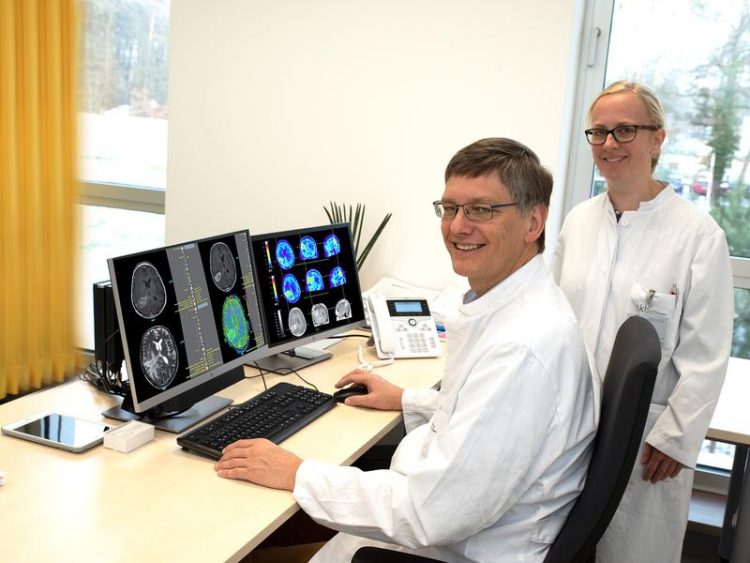Progress in the treatment of aggressive brain tumors

Prof. Dr. Ulrich Herrlinger and Dr. Christina Schaub with pictures of a glioblastoma patient after combination therapy. Photo: © Katharina Wislsperger/Kommunikation und Medien des UKB
In Germany, around 2,400 people are diagnosed with glioblastoma every year. Most of those affected are adults between the ages of 50 and 70. Following radiation therapy, patients currently receive chemotherapy with the substance temozolomide (TMZ).
This is considered the most effective weapon against glioblastoma. The drug alters the DNA in the cancer cells, which die as a result. This stops the growth of the tumor for some time. However, the disease is not yet curable.
Temozolomide is particularly effective in treating a subform of glioblastoma. In this subform, a genetic sequence in the cancer cells, the so-called MGMT promoter, is chemically altered. Experts call this an MGMT promoter methylation. It causes the MGMT gene that is controlled by the promoter to be read less frequently.
This allows temozolomide to attack the tumor better. However, its effect is limited, even in this patient group. Attempts were therefore made to combine the drug with other drugs in order to achieve better results – for a long time without success.
Well-tolerated side effects
A pilot study conducted several years ago gave rise to new hope. Scientists led by Prof. Dr. Ulrich Herrlinger (Department of Neurology and Center for Integrated Oncology (CIO), University Hospital Bonn) administered temozolomide together with CCNU, another cancer drug that has an effect on the DNA. “At the time, we found first indications that this combination might be able to significantly improve the prognosis,” explains Herrlinger.
“In order to confirm these results, we started a large patient trial with funding from the Federal Ministry of Education and Research. We have now been able to show that the administration of CCNU and TMZ actually significantly prolongs the survival time of our patients, and that with well-tolerated side effects.”
A total of 17 centers in Germany with almost 130 patients were involved in the study that has now been published. On average, the patients receiving this kind of treatment survived about four years, more than 16 months longer than with TMZ alone. “This is a major success,” says Herrlinger. “Since the initial approval of temozolomide in 2005, chemotherapy of glioblastoma had made virtually no progress.” The researchers are now trying to further improve the therapy, for example by combining three drugs.
However, only patients with a methylated MGMT promoter benefit from the new treatment approach – just over one third of all patients. “This is a tailor-made therapy for this subgroup,” emphasizes Herrlinger. “Ultimately, this is an initial step toward personalized cancer medicine for glioblastoma patients.” The Neurooncology Center of the University Hospital Bonn now offers these patients the CCNU/TMZ combination also outside of clinical studies.
Prof. Dr. Ulrich Herrlinger
Head of the Clinical Neurooncology Section
Clinic and Polyclinic for Neurology
University Hospital Bonn
Tel. +49(0)228/28731241
E-mail: ulrich.herrlinger@ukbonn.de
Ulrich Herrlinger et al.: Lomustine-temozolomide combination therapy versus standard temozolomide therapy in patients with newly diagnosed glioblastoma with methylated MGMT promotor (CeTeG/NOA-09): a randomised, open label, phase 3 trial; The Lancet; DOI: 10.1016/S0140-6736(18)31791-4
Media Contact
All latest news from the category: Health and Medicine
This subject area encompasses research and studies in the field of human medicine.
Among the wide-ranging list of topics covered here are anesthesiology, anatomy, surgery, human genetics, hygiene and environmental medicine, internal medicine, neurology, pharmacology, physiology, urology and dental medicine.
Newest articles

Silicon Carbide Innovation Alliance to drive industrial-scale semiconductor work
Known for its ability to withstand extreme environments and high voltages, silicon carbide (SiC) is a semiconducting material made up of silicon and carbon atoms arranged into crystals that is…

New SPECT/CT technique shows impressive biomarker identification
…offers increased access for prostate cancer patients. A novel SPECT/CT acquisition method can accurately detect radiopharmaceutical biodistribution in a convenient manner for prostate cancer patients, opening the door for more…

How 3D printers can give robots a soft touch
Soft skin coverings and touch sensors have emerged as a promising feature for robots that are both safer and more intuitive for human interaction, but they are expensive and difficult…





















